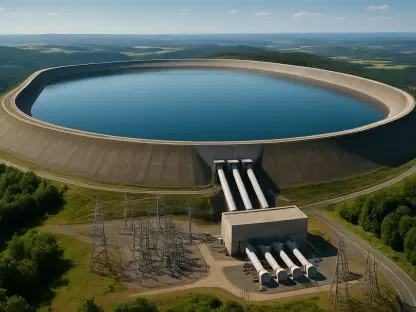The anticipated surge in new electricity load over the next few years is creating challenges for grid operators, utilities, and regulators. This surge has led to speculative behavior among developers, who submit multiple interconnection requests for the same project or for underdeveloped projects, resulting in inefficiencies and “phantom” loads. To address these issues, there is a need for standardization in the interconnection process to reduce speculation and ensure grid reliability and customer protection.
Rising Demand and Speculative Behavior
Anticipated Surge in Electricity Load
The electricity system is bracing for a significant increase in new load, driven by a variety of new large customers willing to pay premium prices for speed and certainty in securing capacity. This anticipated surge follows two decades of stagnant load growth. The demand for electricity is not only increasing, but it is also marked by a diverse set of new large-scale consumers ranging from tech companies to electric vehicle manufacturers. As these new players seek to secure their necessary capacity with urgency, they are often prepared to pay higher prices to obtain the speed and assurance they require. This shift comes as a marked contrast to the prior years of minimal growth in load demand.
Grid operators and utilities are now faced with a rapidly rising need for electricity, which puts pressure on the entire system. The urgency expressed by new consumers willing to invest significantly for reliable and timely interconnection only heightens this pressure. The sudden influx in applications from these entities requires a corresponding increase in system readiness and capacity, pushing the boundaries of existing infrastructures that were once deemed sufficient under slower growth scenarios. As a result, the management, planning, and structuring of interconnection processes must be carefully re-evaluated to adapt to these changing dynamics.
Speculative Behavior Among Developers
The surge in demand has led to speculative behavior, with developers submitting multiple interconnection requests for the same project or for underdeveloped projects. This practice inflates demand projections and introduces inefficiencies in the load interconnection process. Developers, driven by the competitive rush to secure grid capacity quickly, often submit numerous applications for identical projects or projects that may not even be fully developed. This phenomenon of submitting speculative requests results in what the industry terms “phantom” loads, inflating the actual demand and creating a mirage of greater need than genuinely exists.
These inflated demand projections can significantly complicate the task for grid operators and utilities. The presence of phantom loads muddles the genuine demand landscape, making it increasingly challenging to accurately anticipate and plan for future electricity needs. This speculative rush not only disrupts the systematic allocation of resources but also erodes trust within the industry as legitimate projects find it harder to stand out amidst the speculative noise. The uncertainty generated by speculative interconnection requests can lead to suboptimal investments, delayed project timelines, and ultimately impact the overall reliability and efficiency of the electrical grid.
Challenges Faced by Grid Operators and Utilities
Inflated Demand Projections
Speculative interconnection requests create “phantom” loads, which inflate demand projections and introduce uncertainty. This makes it difficult for legitimate projects to distinguish genuine opportunities from speculative noise. Grid operators and utilities are thus left grappling with inflated demand figures that skew planning and investment decisions. These inflated projections lead to a myriad of challenges, including misallocation of resources, investment in unnecessary expansions, and ultimately, inefficiencies in the interconnection process.
Furthermore, the presence of phantom loads undermines the accuracy of load forecasting, which is crucial for maintaining grid stability and reliability. Utilities and grid operators depend on precise demand projections to make informed decisions about infrastructure investment, maintenance schedules, and capacity planning. The speculative behavior that saturates the interconnection queue with unsupported projects hinders this crucial aspect of grid management. As a result, legitimate projects from genuine customers face delays and uncertainties, potentially leading to missed opportunities and lost economic benefits. The challenge lies in separating the genuine load growth signals from the noise created by speculative filings.
Historical Context of Speculative Filings
The current challenges resemble those faced with the generation interconnection process over the last two decades, where speculative filings led to inefficiencies and delays. Efforts by utilities and the Federal Energy Regulatory Commission (FERC) to mitigate these issues have had mixed results. History has shown that speculative behavior in the interconnection process is not unprecedented. During the past two decades, the generation side of interconnection experienced similar issues, where speculative filings contributed to bottlenecks, delays, and inefficiencies. Despite various initiatives and policy changes by utilities and the FERC to address these problems, the outcomes have been inconsistent.
The lessons from the generation interconnection process highlight the importance of proactive measures to prevent speculative behavior. If left unchecked, such behavior can lead to prolonged interconnection timelines, increased costs, and reduced reliability. The historical context underscores the need for a well-defined and enforceable process to ensure that only viable projects advance through the interconnection queue. This requires a combination of regulatory oversight, industry collaboration, and robust evaluation criteria to effectively separate speculative filings from genuine projects. By learning from past experiences, stakeholders can develop strategies to create a more efficient and reliable load interconnection process.
Current Opportunity for Improvement
Need for Standardization
As the volume of load interconnection requests increases, there is a critical juncture to avoid a fragmented approach and introduce standardized processes. A commonsense approach is proposed to address speculative behavior and ensure a more rational interconnection process. The increasing volume of load interconnection requests presents a pivotal moment to reassess and standardize the interconnection process. By adopting a standardized approach, the industry can mitigate the adverse effects of speculative behavior and create a more streamlined and efficient interconnection system. Standardization involves establishing clear, repeatable procedures for submitting and processing interconnection requests, ensuring transparency, and maintaining fairness for all stakeholders.
A standardized process helps to eliminate ambiguity and reduce opportunities for speculative behavior to thrive. It provides a consistent framework for evaluating and prioritizing projects based on objective criteria, such as their financial readiness and commercial viability. This approach minimizes the chances of speculative requests clogging the interconnection queue and ensures that legitimate projects receive the attention they deserve. Moreover, standardization fosters a level playing field for all participants, promoting trust and collaboration among utilities, grid operators, regulators, and developers. By addressing the root causes of speculative behavior through standardization, the industry can enhance grid reliability, efficiency, and overall customer satisfaction.
Proposed Solutions
To manage speculative behavior, several solutions are proposed. These include standardizing the interconnection process, ensuring transparency, avoiding bias, implementing financial readiness criteria, and requiring commercial readiness demonstrations. Standardizing the interconnection process involves creating a clear and consistent set of guidelines that all applicants must follow. This includes specifying the criteria for entering the interconnection queue, the requirements for advancing through it, and the documentation needed to support each application. By establishing a uniform process, grid operators can streamline operations, reduce administrative burdens, and minimize opportunities for speculative behavior.
In addition to standardization, transparency plays a crucial role in mitigating speculative behavior. Providing detailed information about projects in the interconnection queue, including their position, ownership (potentially anonymized), location, size, and progress, enhances accountability and trust. This transparency allows stakeholders to track the progress of their applications, identify potential bottlenecks, and make informed decisions based on accurate and up-to-date information.
To further ensure fairness, the interconnection process must avoid bias and preferential treatment. The criteria for entering and advancing through the queue should be applied consistently to all projects, regardless of their size, ownership, or other factors. This impartiality fosters a level playing field and encourages genuine developers to participate with confidence.
Financial readiness is another critical component in managing speculative behavior. Implementing fees commensurate with the interconnection cost and project size can deter speculative filings and ensure that developers are financially committed to their projects. These fees can be scaled to increase as a project progresses, further discouraging those who are not serious from remaining in the queue.
Finally, requiring demonstrations of commercial readiness helps to filter out nonviable projects. Developers can be asked to provide evidence of their capability, such as a track record of similar projects or an objective test like a reservation or down payment on critical equipment. This requirement ensures that only projects with a genuine likelihood of completion advance through the interconnection process, reducing inefficiencies and delays caused by speculative behavior.
Regulatory Considerations
Aligning Around Standard Principles
Aligning around standard principles can help reduce speculation and create a rational interconnection process. This approach can potentially avoid overly burdensome regulatory oversight. By establishing and adhering to standardized principles, the industry can self-regulate and maintain a fair and efficient interconnection process. These principles include transparency, fairness, financial and commercial readiness, and a clear, repeatable process. Aligning around these standards fosters trust among stakeholders and reduces the need for heavy-handed regulatory interventions.
Standardized principles also provide a framework for continuous improvement. As the industry evolves and new challenges arise, these principles can be adapted to address emerging issues while maintaining the core values of fairness and transparency. This adaptability ensures that the interconnection process remains efficient and responsive to the changing needs of the electricity system. Moreover, aligning around standard principles promotes collaboration among utilities, grid operators, regulators, and developers. By working together within a shared framework, stakeholders can identify best practices, share insights, and develop solutions that benefit the entire industry. This collaborative approach not only enhances the efficiency of the interconnection process but also strengthens the overall resilience and reliability of the grid.
Broader Regulatory Challenges
Two broader issues will require regulatory intervention: the application of sound rate design principles to allocate interconnection costs fairly and the design of flexible interconnection opportunities subject to curtailment to manage new demands effectively. The application of sound rate design principles is essential to ensure that interconnection costs are allocated fairly among large load customers and the system as a whole. This involves evaluating cost causation to determine who benefits from and bears the cost of interconnection upgrades and expansions. Fair cost allocation principles help prevent disputes, promote transparency, and ensure that the financial burden is distributed equitably.
The design of flexible interconnection opportunities subject to curtailment is another critical regulatory challenge. Flexible interconnections allow new large load customers to connect to the grid quickly and cost-effectively while being subject to curtailment during periods of high demand or grid stress. This approach balances the need for timely interconnections with the overall stability and reliability of the grid. Regulatory frameworks must be developed to define the conditions under which curtailment can occur, the compensation mechanisms for affected customers, and the technical requirements for implementing flexible interconnections. These frameworks must be designed to protect both the integrity of the grid and the interests of new large load customers.
Additionally, regulatory oversight is necessary to ensure that standardized principles and processes are consistently applied across the industry. Regulators can provide guidance, monitor compliance, and enforce rules to prevent abuses and maintain the integrity of the interconnection process. By addressing these broader regulatory challenges, stakeholders can create a more robust and equitable interconnection system that supports the growing demand for electricity while maintaining grid reliability and customer satisfaction.
Future Prospects
Immediate Steps for Stakeholders
While waiting for overarching regulatory solutions from FERC and state regulators, stakeholders can begin addressing the load-side interconnection process immediately. Collaboration among utilities, customers, and regulators is essential to achieve a standardized and practical approach. Stakeholders can take several immediate steps to improve the load-side interconnection process. First, utilities and grid operators can work together to develop and implement standardized procedures for submitting and processing interconnection requests. This includes creating clear guidelines for project evaluation, establishing transparency measures, and ensuring impartiality in the queue management process.
Customers, particularly new large load developers, can actively participate in this collaborative effort by providing feedback on the proposed standards and processes. Their insights and experiences can help shape a more practical and user-friendly interconnection system. Additionally, developers can demonstrate their commitment to their projects by meeting financial and commercial readiness criteria early in the process, reducing the likelihood of speculative behavior.
Regulators can play a supportive role by facilitating discussions among stakeholders, providing guidance on best practices, and monitoring compliance with the established standards. They can also identify and address any regulatory barriers that may hinder the implementation of a standardized interconnection process. By taking these immediate steps, stakeholders can create a more efficient and reliable interconnection system that benefits all parties involved.
Enhancing Grid Reliability
The expected rise in new electricity demands over the next few years presents significant challenges for grid operators, utility companies, and regulatory bodies. This increasing demand has spurred speculative actions among developers, who often submit several interconnection applications for the same project or for projects that are underdeveloped. This practice results in inefficiencies and the creation of “phantom” loads, which do not materialize but place undue stress on the system. To tackle these challenges, there is a pressing need for standardizing the interconnection process. By setting clear and uniform guidelines, it would be possible to minimize speculation, enhance grid reliability, and protect consumers. These measures would not only streamline the interconnection process but also ensure that projects that progress are more likely to be viable and meaningful, reducing wasted resources. Standardization can bridge gaps and ensure a more stable and efficient power grid, benefiting all stakeholders involved.









